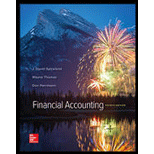
Concept explainers
1.
Accounting equation is an accounting tool expressed in the form of equation, by creating a relationship between the resources or assets of a company, and claims on the resources by the creditors and the owners. Accounting equation is expressed as shown below:
Assets = Liabilities + Shareholders Equity
To analyze: The given transaction and indicate the increase or decrease in the accounting equation.
2.
Journal
Journal is the method of recording monetary business transactions in chronological order. It records the debit and credit aspects of each transaction to abide by the double-entry system.
To record: The
3.
T-account
T-account is the form of the ledger account, where the journal entries are posted to this account. It is referred to as the T-account, because the alignment of the components of the account resembles the capital letter ‘T’.
The components of the T-account are as follows:
a) The title of the account
b) The left or debit side
c) The right or credit side
To prepare: The T-account to enter the transaction from journal assuming opening balance is zero.
Want to see the full answer?
Check out a sample textbook solution
Chapter 2 Solutions
FINANCIAL ACCOUNTINGLL W/CONNECT >IC<
- Isla Innovations purchased a patent on 1 August 2020 for $360,000. The economic benefits were expected to last 10 years, but the patent's legal life was 20 years. Also, during 2020/21, Isla incurred research and development costs of $180,000. What is the carrying amount of the patent on 31 July 2021?arrow_forwardSolve thisarrow_forwardPlease provide correct solution and accounting questionarrow_forward
- What is the amount of income?arrow_forwardDivision Y earned $180,000 in income from operations. Its service department charges are $320,000, and total operating expenses are $1,500,000. What is the total revenue for Division Y? a. $2,000,000 b. $1,680,000 c. $2,100,000 d. $1,820,000arrow_forwardWhat must the owners equity at the beginning of the year have been ? Please give answer the accounting questionarrow_forward
- the finished products are sold?arrow_forwardPerry Company applies overhead on the basis of 200% of direct labor cost. Job No. 486 is charged with $90,000 of direct materials costs and $500,000 of manufacturing overhead. The total manufacturing costs for Job No. 486 is?arrow_forwardAnswer this Questionarrow_forward
- Miller Corporation purchased Elvis Enterprises for $750,000 cash. The fair market value of Elvis's assets was $640,000, and the company had liabilities of $45,000. What amount of goodwill should Miller Corporation record related to the purchase of Elvis Enterprises?arrow_forwardA company expected its annual overhead cost to be $750,000 and direct labor costs to be $900,000. Actual overhead was $730,000, and actual labor costs totaled $950,000. How much is the company's predetermined overhead rate to the nearest cent?arrow_forwardBrill Tech sells its only product for $50 per unit. Variable costs are 60% of the selling price, and fixed costs are $180,000. What is the break-even point in units?arrow_forward
- Principles of Accounting Volume 1AccountingISBN:9781947172685Author:OpenStaxPublisher:OpenStax College
 Cornerstones of Financial AccountingAccountingISBN:9781337690881Author:Jay Rich, Jeff JonesPublisher:Cengage Learning
Cornerstones of Financial AccountingAccountingISBN:9781337690881Author:Jay Rich, Jeff JonesPublisher:Cengage Learning Financial AccountingAccountingISBN:9781337272124Author:Carl Warren, James M. Reeve, Jonathan DuchacPublisher:Cengage Learning
Financial AccountingAccountingISBN:9781337272124Author:Carl Warren, James M. Reeve, Jonathan DuchacPublisher:Cengage Learning  Financial Accounting: The Impact on Decision Make...AccountingISBN:9781305654174Author:Gary A. Porter, Curtis L. NortonPublisher:Cengage Learning
Financial Accounting: The Impact on Decision Make...AccountingISBN:9781305654174Author:Gary A. Porter, Curtis L. NortonPublisher:Cengage Learning College Accounting, Chapters 1-27 (New in Account...AccountingISBN:9781305666160Author:James A. Heintz, Robert W. ParryPublisher:Cengage Learning
College Accounting, Chapters 1-27 (New in Account...AccountingISBN:9781305666160Author:James A. Heintz, Robert W. ParryPublisher:Cengage Learning





